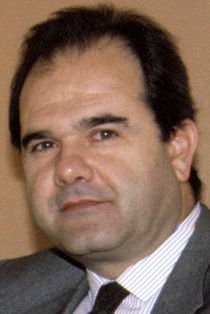Top Qs
Timeline
Chat
Perspective
1994 Andalusian regional election
Election in the Spanish region of Andalusia From Wikipedia, the free encyclopedia
Remove ads
A regional election was held in Andalusia on Sunday, 12 June 1994, to elect the 4th Parliament of the autonomous community. All 109 seats in the Parliament were up for election. The election was held simultaneously with the 1994 European Parliament election.
The candidate for the PSOE, Manuel Chaves, was invested as President of the Regional Government of Andalusia after winning the election. However, the poor results obtained by his party forced him to form a minority government 10 seats short of a majority. Eventually, a snap election had to be called in 1996 due to the impracticality of government resulting from the union, at times, of the two main opposition parties (People's Party and United Left).
Remove ads
Overview
Summarize
Perspective
Electoral system
The Parliament of Andalusia was the devolved, unicameral legislature of the autonomous community of Andalusia, having legislative power in regional matters as defined by the Spanish Constitution and the Andalusian Statute of Autonomy, as well as the ability to vote confidence in or withdraw it from a regional president.[1] Voting for the Parliament was on the basis of universal suffrage, which comprised all nationals over 18 years of age, registered in Andalusia and in full enjoyment of their political rights.
The 109 members of the Parliament of Andalusia were elected using the D'Hondt method and a closed list proportional representation, with an electoral threshold of three percent of valid votes—which included blank ballots—being applied in each constituency. Seats were allocated to constituencies, corresponding to the provinces of Almería, Cádiz, Córdoba, Granada, Huelva, Jaén, Málaga and Seville, with each being allocated an initial minimum of eight seats and the remaining 45 being distributed in proportion to their populations (provided that the number of seats in each province did not exceed two times that of any other).[1][2]
As a result of the aforementioned allocation, each Parliament constituency was entitled the following seats:
In smaller constituencies, the use of the electoral method resulted in an effective threshold based on the district magnitude and the distribution of votes among candidacies.[3]
The electoral law allowed for parties and federations registered in the interior ministry, coalitions and groupings of electors to present lists of candidates. Parties and federations intending to form a coalition ahead of an election were required to inform the relevant Electoral Commission within ten days of the election call, whereas groupings of electors needed to secure the signature of at least one percent of the electorate in the constituencies for which they sought election, disallowing electors from signing for more than one list of candidates.[2][4]
Election date
The term of the Parliament of Andalusia expired four years after the date of its previous election. Election day was to take place between the thirtieth and the sixtieth day from the date of expiry of parliament barring any date within from 1 July to 31 August. The previous election was held on 23 June 1990, which meant that the legislature's term would have expired on 23 June 1994. The election was required to take place no later than the sixtieth day from the date of expiry of parliament on the condition that it was not held between 1 July and 31 August, setting the latest possible election date for the Parliament on Thursday, 30 June 1994.[1][2][5][6]
The Parliament of Andalusia could not be dissolved before the date of expiry of parliament. In the event of an investiture process failing to elect a regional president within a two-month period from the first ballot, the candidate from the party with the highest number of seats was to be deemed automatically elected.[1][5][6]
Remove ads
Parliamentary composition
The Parliament of Andalusia was officially dissolved on 19 April 1994, after the publication of the dissolution decree in the Official Gazette of the Regional Government of Andalusia.[7] The table below shows the composition of the parliamentary groups in the Parliament at the time of dissolution.[8]
Remove ads
Campaign
Election debates
Opinion polls
Summarize
Perspective
The tables below list opinion polling results in reverse chronological order, showing the most recent first and using the dates when the survey fieldwork was done, as opposed to the date of publication. Where the fieldwork dates are unknown, the date of publication is given instead. The highest percentage figure in each polling survey is displayed with its background shaded in the leading party's colour. If a tie ensues, this is applied to the figures with the highest percentages. The "Lead" column on the right shows the percentage-point difference between the parties with the highest percentages in a poll.
Voting intention estimates
The table below lists weighted voting intention estimates. Refusals are generally excluded from the party vote percentages, while question wording and the treatment of "don't know" responses and those not intending to vote may vary between polling organisations. When available, seat projections determined by the polling organisations are displayed below (or in place of) the percentages in a smaller font; 55 seats were required for an absolute majority in the Parliament of Andalusia.
- Color key:
Exit poll
Voting preferences
The table below lists raw, unweighted voting preferences.
Victory preferences
The table below lists opinion polling on the victory preferences for each party in the event of a regional election taking place.
Victory likelihood
The table below lists opinion polling on the perceived likelihood of victory for each party in the event of a regional election taking place.
Remove ads
Results
Overall
Distribution by constituency
Remove ads
Aftermath
Remove ads
Notes
References
Wikiwand - on
Seamless Wikipedia browsing. On steroids.
Remove ads





